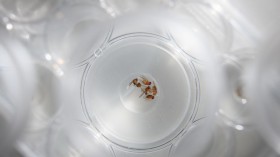Due to a reported outbreak of the invasive cattle screwworm fly, the transport of infected livestock was halted at the Panamanian border.
Outbreak in Panama
In an urgent effort to put an end to an outbreak of invasive cattle screwworms that first emerged near the Panama border last month, Costa Rica is working with Panama and the United States.
The joint program includes the Panama-US Commission for the Eradication and Prevention of Cattle Screwworm (COPEG) and the National Animal Health Service (SENASA).
There have already been seven confirmed screwworm cases in the border area, affecting sheep, cattle, and a dog.
Sterile Male Flies, Traps, and Checkpoints
On July 31 and August 3, planes dropped about 10 million counts of sterile male flies across outbreak areas in an effort to stop the fly's mating cycle. In order to control the population, the airborne discharge will continue as long as necessary.
According to SENASA veterinarian Dr. Alejandra Umana, screwworms have been successfully eradicated in the past using this method of sterile insects. Sterile flies will mate with wild females but give birth to no progeny, which kills the infestation.
To contain the epidemic, ground teams are visiting farms and recording cases at the same time as SENASA has set traps to track the pest's distribution. To prevent the transfer of infected cattle, new animal control checkpoints have been set up near Sabanillas de Limoncito and on the highway leading to Golfito.
The Director of Epidemiology at SENASA, Alexis Sandi, advised Producers to exercise caution and report any signs of possible infestations right away. Early diagnosis and treatment are essential.
All citizens can contribute by alerting SENASA right away if they detect screwworm cases. The organization is implementing increased surveillance across the entire nation to promptly identify new cases before significant agricultural harm occurs.
Angel Gonzalez, the minister of agriculture, swore to battle and never rest until their goal was achieved.
Collaboration between nations as well as between citizens and governments is necessary for the control of invasive pests.
The joint US, Costa Rica, and Panama mission aims to protect the country's economic and biological interests. SENASA requests complete public collaboration and pledges to provide regular updates as work progresses, The Tico Times reports.
Also Read: Garlic Butter Lures in Gnats, Fruit Flies in Queensland Home This Humid Season
Invasive Cattle Screwworm Fly
It had been more than 30 years since the New World screwworm was completely wiped from the United States, and this was the state of Florida's first infection at that time. To stop the spread of screwworm and eradicate screwworm flies from the affected Florida Keys, preserve the endangered Key deer, and safeguard domestic animals and pets on the Keys, the USDA worked in collaboration with the Florida Department of Agriculture and Consumer Services, the US Fish and Wildlife Services, and Florida's Monroe County.
The New World screwworm fly (Cochliomyia hominivorax), which feeds on the flesh of living mammals and, less frequently, birds, is the source of the sickness. The New World screwworm has cost the US livestock business $20 million on average yearly during the past century according to the USDA.
The death rate and decreased meat and milk yield have the most damaging effects on the productivity of cattle. Despite being eradicated from the United States, Mexico, and Central America, the screwworm still exists in several locations across South America and the Caribbean, as per the International Atomic Agency.
Related Article: Invasive Tau Fruit Fly Puts South California Community Under Quarantine, Produce Movement Restricted
© 2024 NatureWorldNews.com All rights reserved. Do not reproduce without permission.





